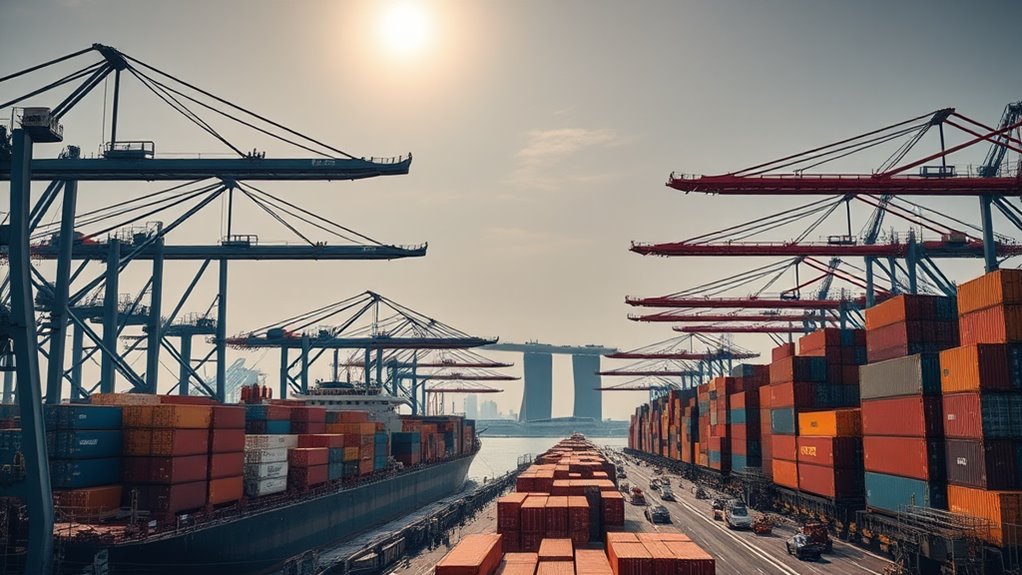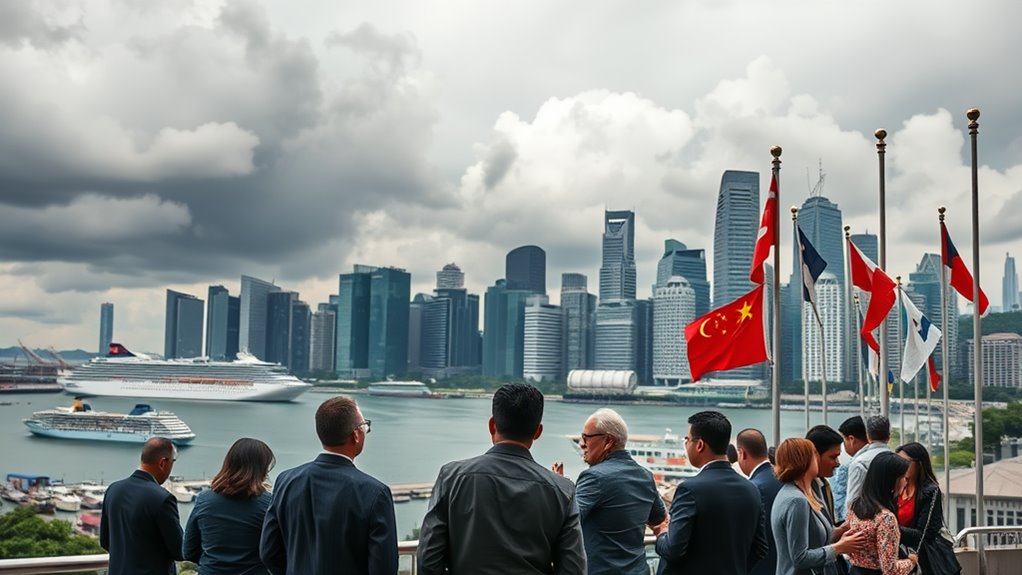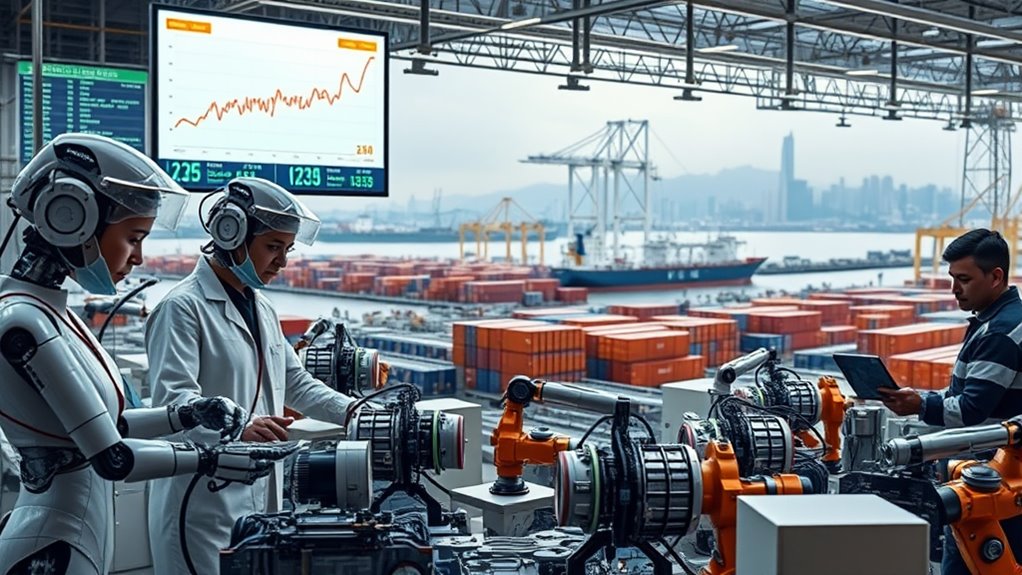Did you know that Singapore's economy could be heavily influenced by global trade tensions in 2025? It's true! The shifting dynamics, especially between the U.S. and China, could change how trade flows through the region. Factors like inflation and political shifts are also in play. Curious about how these challenges might shape Singapore's future? Let's investigate what's at stake and what strategies could help navigate these turbulent waters!
Global Trade Forecast for 2025
As we look ahead to 2025, it's clear that Singapore's economic landscape is set for some interesting twists and turns. You might feel a bit anxious with the growth forecast dropping to 1% to 3%, down from last year's 4%.
But don't worry! The manufacturing sector, especially electronics, is buzzing with excitement. With a predicted 11.2% jump in global semiconductor sales, there's plenty to look forward to.
Plus, Singapore's trade-related services are shining brighter, benefiting from increased trade flows into Southeast Asia. The Johor-Singapore Special Economic Zone is another thrilling project, promising to enhance regional collaboration and investments.
Impact of Geopolitical Tensions
Geopolitical tensions are shaking things up for Singapore's economy, and it's essential to pay attention. These geopolitical risks, especially from the U.S. political landscape, could stifle growth, dropping it to a mere 1% to 3% in 2025.
Ongoing trade conflicts and shifting alliances, like ASEAN states joining BRICS, complicate Singapore's role in global trade. You might feel the impact when supply chains get disrupted and costs rise. This trade-dependent economy needs to keep its eyes on the prize!
Singapore's strategy? Building economic resilience by forging 27 free-trade agreements and engaging in multilateral pacts like RCEP. It's all about staying connected and adapting to these changes—it's a wild ride, but you're on board for the expedition!
Trade-Related Services and Manufacturing Growth

With the global economy shifting gears, Singapore's trade-related services and manufacturing sectors are ready to rev up and drive growth. You're looking at a future where supply chain resilience and manufacturing innovation take center stage. The projected 11.2% rise in global semiconductor sales in 2025 could energize our manufacturing landscape. Plus, the Johor-Singapore Special Economic Zone is primed to attract investments, improving our regional collaboration. Additionally, the health and wellness sector is expected to flourish, providing opportunities for innovative solutions that support the growing consumer prioritization of health.
Here's a snapshot:
| Sector | Growth Drivers | Expected Impact |
|---|---|---|
| Trade Services | Electronics, Finance, ICT | Increased external demand |
| Manufacturing | Semiconductor sales | Amplified production |
| JS-SEZ | Data Centers, Renewable Energy | Boosted investment |
| Supply Chain Resilience | Just-in-case models | Better regional stability |
Let's welcome this exciting growth!
Inflation Uncertainties Ahead
Inflation's a tricky beast, especially when you consider the uncertainties on the horizon for Singapore. Core inflation's expected to hover between 1.5% and 2.5% in 2025.
Why? Well, potential US trade sanctions add to the mix. You're also looking at rising wage growth, which could push prices up, even as job vacancies fluctuate.
The upcoming Budget aims to tackle cost pressures directly, showing the government's focus on easing your financial burdens.
Good news, though! Headline inflation is projected to dip to 1.7%, down from 2.4%.
With global commodity prices for energy and food stabilizing, and the Singapore dollar gradually appreciating, you might find some relief.
Keep your eyes peeled; these inflation trends could surprise you!
Political Landscape and Its Implications

As the global stage shifts, Singapore finds itself traversing a complex political landscape that directly impacts its economic future.
You see, political alliances and trade negotiations are key. With ASEAN states joining BRICS, the region's dynamics are changing fast. Singapore's got to juggle its relationships with major powers while staying true to its trading roots.
Political alliances and trade negotiations are crucial as ASEAN states shift toward BRICS, reshaping Singapore's strategic landscape.
It's signed 27 free-trade agreements that cover 90% of its trade—pretty impressive, right? But watch out! Political tensions, like US trade sanctions, can throw a wrench in the works.
Singapore's involved in multilateral pacts like RCEP to cut tariffs and promote a rules-based order. By staying proactive, Singapore can tackle trade tensions and capitalize on its strengths in trade and manufacturing. Additionally, understanding the importance of business registration is crucial for startups to thrive in this evolving environment.
Johor-Singapore Special Economic Zone Opportunities
The Johor-Singapore Special Economic Zone (JS-SEZ) opens up an exciting world of possibilities for both Singapore and Malaysia.
Imagine a space where industries like data centers, renewable energy, and tourism thrive! You'll find that the JS SEZ benefits not only local economies but also creates a vibrant hub for cross-border collaboration.
With the Johor Bahru-Singapore Rapid Transit System Link set to improve connectivity by 2026, moving between the two regions will be a breeze. This means easier business operations and a flourishing job market.
Sure, there are challenges to tackle, like manpower and business ease, but 2025 could be a turning point.
Accept the opportunities ahead! It's time to think big and seize the moment!
AI and Productivity in Manufacturing

In the exciting world of manufacturing, AI is shaking things up in Singapore! The future is bright as AI integration brings major productivity improvement.
Here's how it's transforming the game:
- Tailored Solutions: Companies are crafting customized AI solutions for their unique needs. This isn't one-size-fits-all; it's about getting what works for you.
- Broader Access: The Singapore Business Federation is pushing to make AI accessible for all manufacturers, big and small. Everyone deserves a chance to innovate!
- Boosting Efficiency: Expect significant productivity gains, especially in larger firms. When AI tackles the hard stuff, you can focus on creativity and growth.
Embrace these changes! AI isn't just a tool; it's your new partner in revolutionizing the manufacturing landscape.
Trade Policy Adaptations
Steering through global trade tensions isn't just a challenge; it's an opportunity for Singapore to adapt and thrive.
You see, Singapore's trade policy adaptations are essential for maintaining economic stability. With 27 free trade agreements covering 90% of trade, the nation's got a solid foundation. These agreements help cushion against geopolitical uncertainties and protect supply chains.
Plus, Singapore's commitment to a multilateral rules-based order promotes international cooperation, which is critical in these turbulent times. The Johor-Singapore Special Economic Zone is another smart move, enhancing regional ties and improving trade-related services.
Singapore's dedication to multilateralism and the Johor-Singapore Special Economic Zone strengthens regional cooperation and trade resilience.
As we look ahead to 2025, resilient demand in electronics and ICT will drive our economy forward, despite the ongoing trade tensions. Additionally, understanding business licensing types will be crucial for local entrepreneurs to seize new opportunities in this evolving landscape. Exciting times ahead!
Long-Term Economic Strategies and Support Measures

Steering through global trade challenges isn't just about survival; it's also about seizing opportunities for growth.
Singapore's approach blends fiscal sustainability with household support, ensuring you thrive even in tough times. Here's how:
- Forward Singapore Plan: This focuses on long-term investments in housing, healthcare, and workforce transformation. It's about building a solid future.
- Immediate Support Measures: With a surplus of SGD 1.8 billion, the government can provide targeted help for households facing economic pressures in 2025.
- Trade Agreements: Engaging in 27 free trade agreements enhances our competitiveness. It's crucial for keeping our economy open and resilient.
Additionally, understanding the importance of business structures can help entrepreneurs navigate through these challenging times by making informed decisions.
Conclusion
In summary, Singapore's economic future in 2025 is buzzing with challenges and opportunities! Did you know that Singapore is the world's second-largest exporter of goods relative to its GDP? That's impressive! Maneuvering through trade tensions and adapting to geopolitical shifts will be essential. Embracing innovation and strengthening trade agreements can help Singapore rise above obstacles. So, keep an eye on these developments; they're shaping the future of this vibrant trade hub! Exciting times lie ahead!